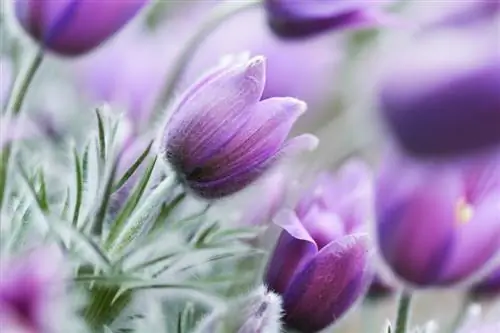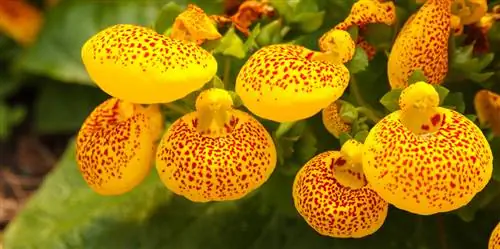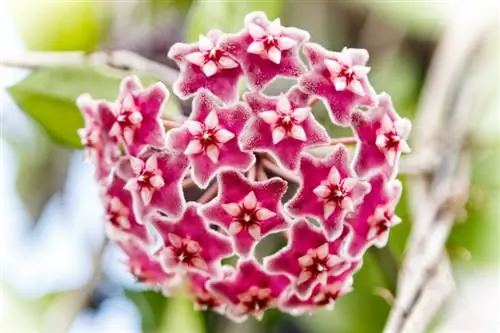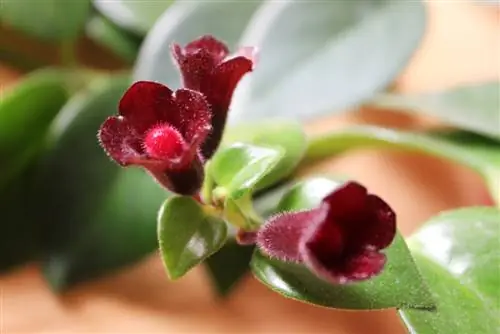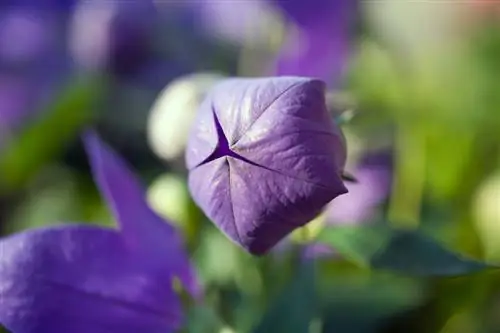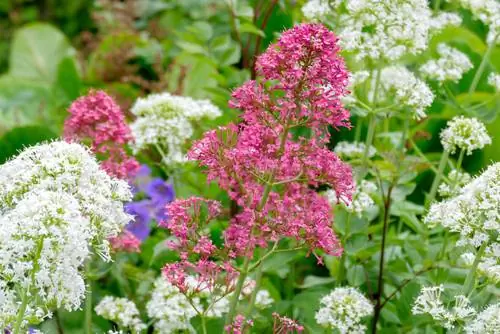- Author admin [email protected].
- Public 2023-12-25 17:45.
- Last modified 2025-01-23 11:22.
At the latest when its nodding bell flowers open in the spring sun, the pasqueflower or pasqueflower can no longer deny its proximity to the anemone. The delicately hairy foliage and the feathery fruit clusters also underline the picturesque effect of this pretty rock garden flower. If you still have unanswered questions about care, you can find the answer here.
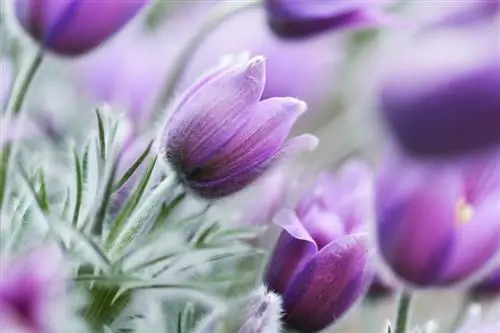
What are the ideal conditions for the pasque flower in the garden?
The pasqueflower is an attractive rock garden plant that flowers from April to May and prefers sandy-loamy, calcareous and dry soil. It requires little care and grows best in sunny locations. For propagation, rhizomes are used or cold germination is used.
Planting the pasqueflower correctly
In late summer and autumn, the sun-warmed garden soil is particularly friendly to young perennials. Therefore, August and September are planting times for the pasque flower. While the root ball is still potted in a container with water, prepare the soil in a sunny, sandy, dry location until it is finely crumbled. The planting pits are ideally located 20 to 30 cm apart and are about twice as large as the root ball. If in doubt, enrich the excavation with a little sand and rock dust. There is no need to add compost to these spring flowers. Do not plant the potted plant deeper than the lower leaves. After the soil has been compacted with your hands, water it a little.
Care tips
Planted with expertise, the pasque flower hardly requires any horticultural attention. If summer is dry, water the flower in the bed. This measure is necessary regularly in the planter if the substrate has dried out. The pasqueflower does not receive fertilizer. To enjoy the eye-catching feather tail fruits, do not clean out the wilted flowers. Only when the spherical fruits have sailed away do you cut the plant off close to the ground. During the winter, a pasque flower stays in the pot in the frost-free winter quarters, where it is only watered so often that the root ball does not dry out.read more
Which location is suitable?
The pasque flower reaches its optimum in sun-drenched stone structures, steppe heather beds or roof gardens. The spring flower feels best when the soil is sandy-loamy and dry, with a medium to high lime content.read more
The correct planting distance
With an average height of 25 cm, we recommend a planting distance of 20 to 30 cm. If the pasque flower inhabits a larger area, you can get by with 15 to 17 specimens per square meter so that the flowers thrive across the board. In the balcony box, the distance to the plant neighbors is reduced by 5-7 cm, due to the special conditions in planters.
What soil does the plant need?
If the soil at the chosen location is equal to the conditions in the mountains, the pasqueflower will happily stretch out its roots. The soil should be poor in nutrients, sandy, dry and well-drained. The majority of spring messengers prefer a calcareous substrate, so adding rock dust or algae lime to the planter is an advantage.
When is flowering time?
The central flowering period of a pasqueflower extends from April to May. In years with mild winters, in a warm and protected location, the graceful nodding bell flowers appear as early as March and last until June. This makes bees and butterflies very happy, as this early source of food is very welcome to them.read more
Cut the pasque flower correctly
A hasty pruning deprives the pasque flower of one of its most attractive attributes. After flowering, spherical fruits with a decorative feathery tail grow. In order to experience this natural spectacle, the plant is only pruned when the feather-tailed fliers have sailed away and the leaves have completely yellowed. Prudent hobby gardeners leave the delicately hairy foliage on the plant until late winter because it acts as a natural winter coat.
Watering the pasque flower
In normal weather conditions, Mother Nature takes over the water supply for a pasque flower in the bed. The watering can is only used when there is a long summer drought. When cultivated in a pot or balcony box, water the pasqueflower whenever the top 3-4 cm of the substrate has dried.
Wintering
The pasque flower is frost-resistant down to -28 degrees Celsius. If you leave the densely hairy foliage on the plant, this precaution is sufficient as winter protection. If you care for the spring flower in a bucket or balcony box, it will spend the cold season in the bright, frost-free winter quarters, where it will be watered from time to time.
Propagate pasqueflower
Thanks to its strong rhizomes, the pasque flower supplies vital material for propagation on its own. The long roots extend far into the ground and allow numerous offspring to thrive at some distance from the mother plant. Once they have reached a height of 5-10 cm, dig up the young plants. Planted in a lean substrate, water your plants every now and then while a new root system develops. As soon as the pot is completely rooted, plant the new pasqueflowers.
Compared to this vegetative propagation, generative breeding through sowing is more complex. Since these are cold germinators, only stratification puts the seeds in the mood to germinate. This can be done by placing the seeds in a plastic bag with moist sand in the vegetable compartment of the refrigerator for 4-6 weeks. Following this cold stimulus, the usual sowing protocol comes into effect in a partially shaded location at a constant 20-23 degrees Celsius.read more
Pasque flower in pot
Is pasqueflower poisonous?
Since the pasqueflower is part of the buttercup family, it is one of the poisonous plants. All parts of the plant are permeated by toxic protoanemonin. If flowers and leaves are eaten, dramatic symptoms of poisoning result. As if that weren't enough, the plant sap causes inflammation, blisters and swelling when it comes into contact with the skin. It is therefore essential to wear gloves during all planting and care work. Children and pets should not be allowed near a pasque flower unsupervised.read more
Trivia
Are you wondering what the pasque flower has to do with a kitchen? In fact, there is no connection in this regard. Rather, the name results from the original trivialization of the name Kuhschelle 'Kühschellchen'. It didn't take long until the common vernacular formulated the pasque flower for the sake of simplicity.
Beautiful varieties
- Blue Bell: Charming pasqueflower with bright blue bell flowers that open like a key
- White Swan: The variety blooms in pure white from March to the beginning of May and stretches up to 40 cm in height
- Red Bell: The variety name says it all, because the red flowers herald the start of spring from March
- Haller's Pasque Flower: The variety native to the Alps blooms from May to July with blue-violet, hairy flowers
- Pasque Flower: It boasts extra large, 5 cm flowers in rich black-violet and purple

